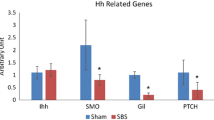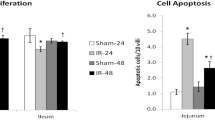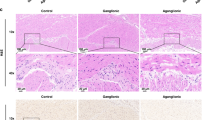Abstract
Purpose
One of the major regulators of gastrointestinal tract development is the hedgehog signaling pathway. The purpose of this study was to evaluate the role of sonic hedgehog (SHh) signaling 24 and 48 h following intestinal ischemia–reperfusion (IR) in a rat.
Materials and methods
Male rats were divided into four experimental groups: (1) Sham-24 h rats underwent laparotomy and were sacrificed after 24 h, (2) Sham-48h rats underwent laparotomy and were sacrificed after 48 h, (3) IR-24h rats underwent occlusion of both superior mesenteric artery and portal vein for 20 min followed by 24 h of reperfusion, and (4) IR-48 h rats underwent ischemia for 20 min followed by 48 h of reperfusion. Intestinal structural changes, enterocyte proliferation and enterocyte apoptosis were determined by immunohistochemistry 24 and 48 h following IR. SHh-related genes and protein expression were determined using real-time PCR, Western blot and immunohistochemistry.
Results
IR-24 rats demonstrated a significant decrease in Shh, Ihh, GIL and Ptch2 mRNA in jejunum and ileum compared to Sham-24 animals that was accompanied by a significant decrease in the number of SHH-positive cells (Immunohistochemistry) in jejunum (2.5-fold decrease) and ileum (37%). After 48 h, IR rats demonstrated a significant increase in Dhh, Ihh, Gil and PTCH2 mRNA in jejunum as well as in Dhh, Ihh, SMO, GIL, PTCH2 mRNA in ileum compared to IR-24 animals that was coincided with increased number of SHH-positive cells in jejunum (2.6-fold increase) and ileum (1.4-fold increase).
Conclusions
24 h following intestinal IR, inhibited cell turnover was associated with inhibited SHh signaling pathway. Signs of intestinal recovery appeared 48 h after IR and were correlated with increase in SHh signaling pathway activity.





Similar content being viewed by others
References
Carden DL, Granger DN (2000) Pathophysiology of ischemia-reperfusion injury. J Pathol 190:255–266
Kurose I, Argenbright LW, Wolf R et al (1997) Ischemia/reperfusion-induced microvascular dysfunction: role of oxidants and lipid mediators. Am J Physiol 272:H2976–H2982
Mangino MJ, Mangino JE, Murphy MK et al (1996) Arachidonic acid metabolism in intestinal hypothermic preservation injury. Cryobiology 33:404–412
Wolin MS (2000) Interactions of oxidants with vascular signaling systems. Arterioscler Thromb Vasc Biol 20:1430–1442
Mangino JE, Kotadia B, Mangino MJ (1996) Characterization of hypothermic intestinal ischemia-reperfusion injury in dogs. Effects of glycine. Transplantation 62:173–178
Schoenberg MH, Poch B, Younes M et al (1991) Involvement of neutrophils in postischemic damage to the small intestine. Gut 32:905–912
Yamamoto S, Tanabe M, Wakabayashi G et al (2001) The role of tumor necrosis factor-alpha and interleukin-1beta in ischemia-reperfusion injury of the rat small intestine. J Surg Res 99:134–141
Ikeda H, Suzuki Y, Suzuki M et al (1998) Apoptosis is a major mode of cell death caused by ischemia and ischemia/reperfusion injury to the rat intestinal epithelium. Gut 42:530–537
Noda T, Iwakiri R, Fujimoto K et al (1998) Programmed cell death induced by ischemia-reperfusion in rat intestinal mucosa. Am J Physiol Gastrointest Liver Physiol 274:G270–G276
De Santa Barbara P, van den Brink GR, Roberts DJ (2003) Development and differentiation of the intestinal epithelium. Cell Mol Life Sci 60:1322–1323
Haegebarth A, Clevers H (2009) Wnt signaling, Lgr5, and stem cells in the intestine. Am J Pathol 174:15–21
Van de Wetering M, Sancho E, Verweij C (2002) The β-catenin/TCF-4 complex impoves a crypt progenitor phenotype on colorectal cancer cells. Cell 111:241–250
Sukhotnik I, Dorfman T, Halabi S et al (2016) Accelerated intestinal epithelial cell turnover after bowel resection in a rat is correlated with inhibited hedgehog signaling cascade. Pediatr Surg Int 32:1133–1140
Roberts DJ, Smith DM, Goff DJ et al (1998) Epithelial-mesenchymal signaling during the regionalization of the chick gut. Development 125:2791–2801
van den Brink GR (2007) Hedgehog signaling in development and homeostasis of the gastrointestinal tract. Physiol Rev 87:1343–1375
Bitgood MJ, McMahon AP (1995) Hedgehog and Bmp genes are coexpressed at many diverse sites of cell-cell interaction in the mouse embryo. Dev Biol 172:126–138
Iwamoto M, Hoffenberg EJ, Carethers JM et al (2005) Nuclear accumulation of beta-catenin occurs commonly in the epithelial cells of juvenile polyps. Pediatr Res 57:4–9
Park PO, Haglund U, Bulkley GB et al (1990) The sequence of development of intestinal tissue injury after strangulation ischemia and reperfusion. Surgery 107:574–580
Madison BB, Braunstein K, Kuizon E, Portman K, Qiao XT, Gumucio DL (2005) Epithelial hedgehog signals pattern the intestinal crypt-villus axis. Development 132:279–289
Wang LC, Nassir F, Liu ZY, Ling L, Kuo F, Crowell T, Olson D, Davidson NO, Burkly LC (2002) Disruption of hedgehog signaling reveals a novel role in intestinal morphogenesis and intestinal-specific lipid metabolism in mice. Gastroenterology 122:469–482
Haj B, Sukhotnik I, Shaoul R, Pollak Y, Coran AG, Bitterman A, Matter I (2014) Effect of ozone on intestinal recovery following intestinal ischemia-reperfusion injury in a rat. Pediatr Surg Int 30:181–188
Sukhotnik I, Slijper N, Pollak Y, Chemodanov E, Shaoul R, Coran AG, Mogilner JG (2011) Parenteral omega-3 fatty acids (Omegaven) modulate intestinal recovery after intestinal ischemia-reperfusion in a rat model. J Pediatr Surg 46:1353–1360
Noda T, Iwakiri R, Fujimoto K, Matsuo S, Aw TY (1998) Programmed cell death induced by ischemia-reperfusion in rat intestinal mucosa. Am J Physiol 274:G270–G276
Coopersmith CM, O’Donnell D, Gordon JI (1999) Bcl-2 inhibits ischemia-reperfusion-induced apoptosis in the intestinal epithelium of transgenic mice. Am J Physiol 276:G677–G682
Hirata-Tominaga K Nakamura T, Okumura N, Kawasaki S, Kay EP, Barrandon Y, Koizumi N, Kinoshita S (2013) Corneal endothelial cell fate is maintained by LGR5 through the regulation of hedgehog and Wnt pathway. Stem Cells31:1396–1407
Tian A, Jiang J (2015) Hedgehog fuels gut regeneration. J Cell Biol 208:807–819
Funding
This research did not receive any specific grant from funding agencies in the public, commercial, or not- for-profit sectors.
Author information
Authors and Affiliations
Corresponding author
Ethics declarations
Conflict of interest
The author(s) declare that they have no conflict of interest.
Rights and permissions
About this article
Cite this article
Ben-Shahar, Y., Pollak, Y., Bitterman, A. et al. Sonic hedgehog signaling controls gut epithelium homeostasis following intestinal ischemia–reperfusion in a rat. Pediatr Surg Int 35, 255–261 (2019). https://doi.org/10.1007/s00383-018-4406-2
Accepted:
Published:
Issue Date:
DOI: https://doi.org/10.1007/s00383-018-4406-2




